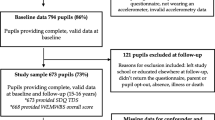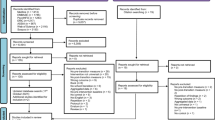Abstract
Objective
To identify determinants of good Health Related Quality of Life (HRQoL) in school going adolescents.
Methods
This Cross-sectional study was conducted in public and private schools in Lucknow, Northern India after obtaining institutional ethical clearance. Children aged 10 to 19 years were included after obtaining parental written informed consent. HRQoL was assessed using culturally appropriate WHOQOL-BREF version.
Results
From 1900 schools in Lucknow, 10 public and 10 private schools were selected. Within schools, random selection of the subjects was done. Dropout rate was 7.2% (525/566). Mean age of participants was 14.04 ± 2.09 years, of which 52.4% (275/525) were boys and 48.5% (255/525) were from private schools. Good HRQoL was a score ≥83, which corresponded to third quartile, and 33.7% and 16.6% of subjects, from private and public schools, respectively, fell in this category (p-value <0.0001). Determinants of good HRQoL on multivariate analysis were age <14 years (OR: 2.11, 95%CI 1.39–3.02, p < 0.0001) and studying in private school (OR = 2.04, 95%CI 1.18–3.51, p < 0.0001).
Conclusions
Younger adolescent age and enrolment in private schools are determinants of good HRQoL in school-going adolescents. Further research is needed to identify measures to improve HRQoL among older adolescents and those studying in public schools.


Similar content being viewed by others
References
Report of the Working Group on Adolescents for the Tenth Five Year Plan. Planning Commission. Government of India. Available from: www.planningcommission.nic.in/aboutus/committee/wrkgrp/wg_adolcnts.pdf. Accessed on Oct 9th 2008.
Hallfors D, Brodish PH, Khatapoush S, Sanchez V, Cho H, Steckler A. Feasibility of screening adolescents for suicide risk in “real world” high school settings. Am J Public Health. 2006;96:282–7.
Sumter SR, Bokhorst CL, Steinberg L, Westenberg PM. The developmental pattern of resistance to peer influence in adolescence: will the teenager ever be able to resist? J Adolesc. 2009;32:1009–21.
Raphael D. Determinants of health of North-American adolescents: evolving definitions, recent findings, and proposed research agenda. J Adolesc Health. 1996;19:6–16.
World Health Organization. WHOQOL user manual (WHO/MNH/MHP/98.4. Rev.1). Programme on mental health. Division of mental health and prevention of substance abuse. Geneva: World Health Organization; 1998.
Eiser C, Morse R. Quality-of-life measures in chronic diseases of childhood [Methodology]. Health Technol Assess. 2001;5:1–158.
Simeoni MC, Sapin C, Antoniotti S, Auquier P. Health-related quality of life reported by French adolescents: a predictive approach of health status? J Adolesc Health. 2001;28:288–94.
National Council for Educational Research and Training (NCERT), Government of India. Available from http://gov.ua.nic.in/Nscheduledata/main3.aspx. Accessed on 16th March 2010.
The Indian Public School System: Time for a Quality Revolution. The ICICI Foundation for Inclusive Growth (IFIG) in collaboration with McKinsey & Company. Available from http://asercentre.org/. Accessed on 5th January 2010.
Agnihotri K, Awasthi S, Chandra H, Singh U, Thakur S. Validation of WHOQOL-BREF instrument in Indian adolescents. Indian J Pediatr. 2010;77:381–6.
Chan YH. Biostatistics 104: correlational analysis. Basic statistics for doctors. Singapore Med J. 2003;44:614–9.
Jirojanakul P, Skevington SM, Hudson J. Predicting young children’s quality of life. Soc Sci Med. 2003;57:1277–88.
Shah PJ, Munzinger CB. Policy review. Education vouchers: global experience and India’s promise. Available from http://www.ccsindia.org/policyreview.asp. Accessed on 14th December 2006.
Rueden UV, Gosch A, Rajmil L, Bisegger C, Sieberer UR, European KIDSCREEN group. Socioeconomic determinants of health related quality of life in childhood and adolescence: results from a European study. J Epidemiol Community Health. 2006;60:130–5.
Baird R. Private schools for the poor: development, provision, and choice in India. A Report for Gray Matters Capital. May 2009. Available from: www.dise.in/Downloads/DISEnstudies/Ross%20Baird.pdf. Accessed on: 24.10.2009.
Hanh VTX, Guillemin F, Cong DD, Parkerson GR, Thu PB, Quynh PT. Health related quality of life of adolescents in Vietnam: cross-cultural adaptation and validation of the adolescent duke health profile. J Adolesc. 2008;28:127–46.
Meuleners LB, Lee AH. Adolescent quality of life: a school-based cohort study in Western Australia. Pediatr Int. 2003;45:706–11.
Barahmand U. Age and gender differences in adolescent worry. Pers Individ Differ. 2008;45:778–83.
Avasarala K. Quality-of-life assessment of family planning adopters through user perspectives in the District of Karimnagar. Indian J Community Med. 2009;34:24–8.
Fact sheet. Towards 7 billion: Why world population is still growing. population action international. Available from www.populationaction.org. Accessed on 15 April 2010.
Contributions
KA, SA; contributed to study design, data analysis, interpretation and manuscript writing. SA; conceptualized the study. KA; contributed to data collection. HC, US and ST ; contributed to interpretation. US also contributed to statistical analysis.
Conflict of Interest
None.
Role of Funding Source
KA currently employed as Senior Research Fellow (Indian Council of Medical Research, New Delhi, INDIA).
Author information
Authors and Affiliations
Corresponding author
Rights and permissions
About this article
Cite this article
Awasthi, S., Agnihotri, K., Singh, U. et al. Determinants of Health Related Quality of Life in School-Going Adolescents in Northern India. Indian J Pediatr 78, 555–561 (2011). https://doi.org/10.1007/s12098-010-0305-9
Received:
Accepted:
Published:
Issue Date:
DOI: https://doi.org/10.1007/s12098-010-0305-9




